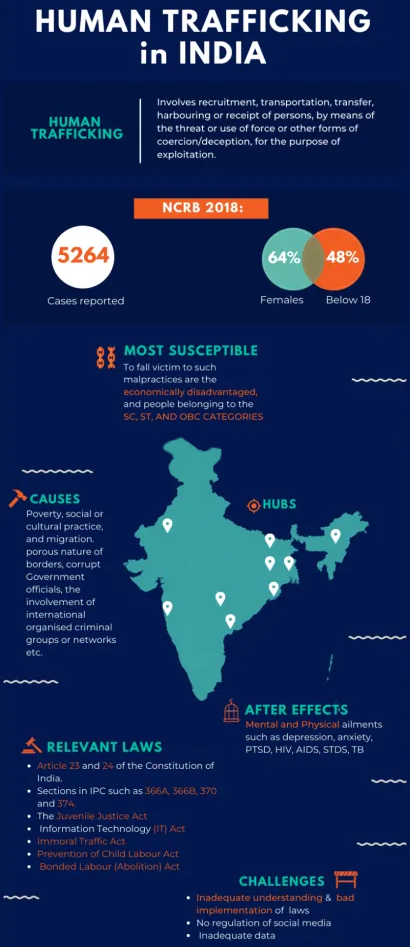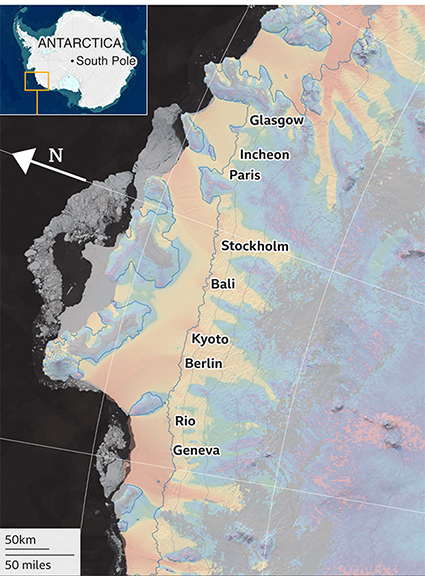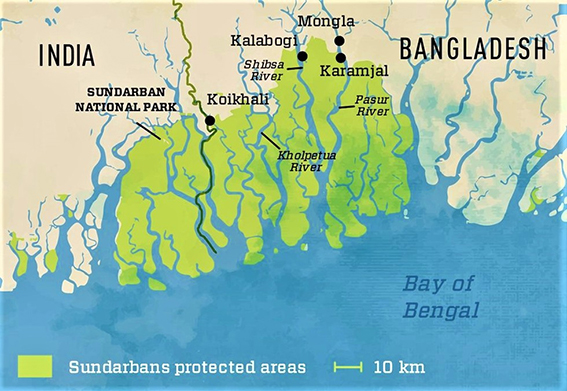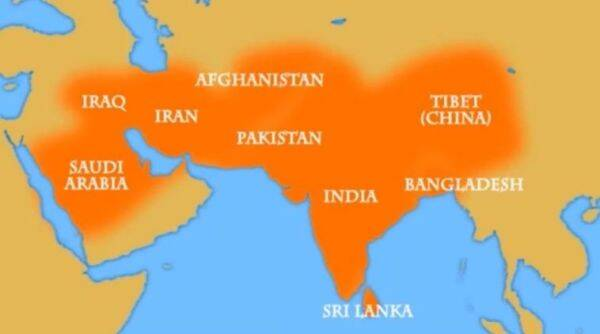Social Justice
Protocol to Prevent Human Trafficking: SCO
Why in News
Recently, the Shanghai Cooperation Organisation (SCO), in its 19th meet (of Prosecutors General) held in New Delhi, adopted a protocol to strengthen cooperation in preventing and combating growing menace of human trafficking, especially women and children.
- The current chair of SCO is Tajikistan.
SCO
- It was founded at a summit in Shanghai in 2001 by the presidents of Russia, China, the Kyrgyz Republic, Kazakhstan, Tajikistan and Uzbekistan.
- Presently, it comprises eight member states namely India, Kazakhstan, China, the Kyrgyz Republic, Pakistan, the Russian Federation, Tajikistan and Uzbekistan.
- India was made an observer at the SCO in 2005.
- India and Pakistan became its permanent members in 2017.
- Recently, Iran’s bid to become a full member of the SCO has been approved.
- It is headquartered in Beijing, China.
- RATS (Regional Anti-Terrorist Structure) is a permanent organ of the SCO, headquartered in Tashkent, Uzbekistan.
- The summit is held annually and chairmanship goes to the member states for a year on rotation basis.
Key Points
- Human Trafficking:
- Human trafficking involves recruitment, transportation, transfer, harbouring or receipt of persons, by means of the threat or use of force or other forms of coercion, for the purpose of exploitation.
- Exploitation include, at a minimum, the exploitation of the prostitution of others or other forms of sexual exploitation, forced labour or services, slavery or practices similar to slavery, servitude, or the removal of organs.
- About the Protocol:
- Calls for continuation of exchange of national legislation to combat the menace of trafficking in persons.
- Seeks to provide protection and assistance to victims of trafficking within their competence.
- Calls for developing cooperation between the educational organisations of the SCO member states in the field of advanced training of prosecutors, whose competence include combating trafficking in persons especially, women and children.
- Relevant Laws in India:
- Immoral Traffic (Prevention) Act 1956 is the premier legislation to deal with this issue.
- Article 23 and 24 (Right Against Exploitation) of the Constitution of India.
- 25 sections in IPC such as 366A, 366B, 370 and 374.
- The Juvenile Justice Act and the Information Technology (IT) Act and also the Prevention of Child Labour Act, the Bonded Labour (Abolition) Act, among others.
- India’s Efforts in Combating Human Trafficking:
- In July 2021, the Ministry of Women and Child Development released Draft anti-trafficking Bill, the Trafficking in Persons (Prevention, Care and Rehabilitation) Bill, 2021.
- India has ratified the United Nations Convention on Transnational Organised Crime (the Palermo Convention) which among others has a Protocol to Prevent, Suppress and Punish Trafficking in Persons, especially Women and Children.
- India has ratified the SAARC Convention on Preventing and Combating Trafficking in Women and Children for Prostitution.
- Anti-Trafficking Nodal Cell was set up in the Ministry of Home Affairs (MHA) in 2006 to act as a focal point for communicating various decisions and follow up on action taken by the State Governments to combat the crime of Human Trafficking.
- Judicial Colloquium: In order to train and sensitize the trial court judicial officers, Judicial Colloquium on human trafficking are held at the High court level.
- Ministry of Home Affairs under a Comprehensive Scheme ‘Strengthening Law Enforcement Response in India against Trafficking in Persons’ through Training and Capacity Building, has released fund for establishment of Anti Human Trafficking Units for 270 districts of the country.
- The Ujjawala scheme was launched in 2007 to put an end to the trafficking of children and women. The objective of the scheme is to prevent, rescue, rehabilitate, reintegrate, and repatriate victims trafficked for commercial sexual exploitation.
- Various initiatives such as “SwadharGreh Scheme”, “Sakhi”, “Universalization of Women Helpline”, provide for a supportive institutional framework and mechanism for addressing concerns of women affected by violence.
Social Justice
Health Insurance for India’s Missing Middle
Why in News
Recently, NITI Aayog has released a comprehensive report titled Health Insurance for India’s Missing Middle.
- The report brings out the gaps in the health insurance coverage across the Indian population and offers solutions to address the situation.
Key Points
- Importance of Health Insurance:
- Health insurance is a mechanism of pooling the high level of Out of Pocket expenditure (OOPE) in India to provide greater financial protection against health shocks.
- Pre-payment through health insurance emerges as an important tool for risk-pooling and safeguarding against catastrophic (and often impoverishing) expenditure from health shocks.
- Moreover, pre-paid pooled funds can also improve the efficiency of healthcare provision.
- Health Insurance: Need And Landscape
- Achieving Universal Health Coverage: Expansion of health insurance coverage is a vital step, and a pathway in India’s effort to achieve Universal Health Coverage (UHC).
- Low Government expenditure on health has constrained the capacity and quality of healthcare services in the public sector.
- It diverts the majority of individuals – about two-thirds – to seek treatment in the costlier private sector.
- High Out-of-Pocket Expenditure: India’s health sector is characterized by low Government expenditure on health, high out-of-pocket expenditure (OOPE), and low financial protection for adverse health events.
- The private sector is characterized by high OOPE, leading to low financial protection
- Missing Middle: According to the report, at least 30% of the population, or 40 crore individuals (referred as the missing middle in this report) are devoid of any financial protection for health.
- The Ayushman Bharat – Pradhan Mantri Jan Arogya Yojana (AB-PMJAY) and various State Government extension schemes, provide comprehensive hospitalization cover to the bottom 50% of the population.
- Around the top 20% of the population – 25 crore individuals – are covered through social health insurance, and private voluntary health insurance.
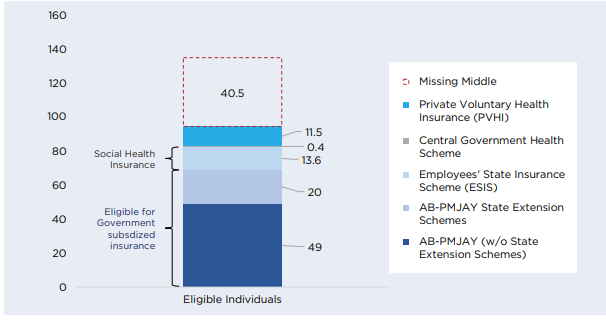
- Existing Health Insurance, But not Suitable For The Missing Middle:
- In the absence of a low-cost health insurance product, the missing middle remains uncovered despite the ability to pay nominal premiums.
- Affordable contributory products such as Employees' State Insurance Corporation (ESIC), and Government subsidized insurance including AB-PMJAY are closed products.
- They are not available to the general population due to the risk of adverse selection.
- Achieving Universal Health Coverage: Expansion of health insurance coverage is a vital step, and a pathway in India’s effort to achieve Universal Health Coverage (UHC).
- Recommended Insurance Models: The report has recommended three models for increasing the health insurance coverage in the country:
- Creation of a Large and Diversified Risk Pool: The success of a private voluntary contributory health insurance product requires creation of a large and diversified risk pool.
- For this to happen the Government should build consumer awareness of health insurance through Information Education Communication campaigns.
- Developing a Modified, Standardized Health Insurance Product: The cost of health insurance i.e., the premium needs to come down, in line with the affordability of the missing middle.
- For example, Aarogya Sanjeevani can be made affordable.
- Aarogya Sanjeevani is a standardised health insurance product launched by the Insurance Regulatory Development Authority of India (IRDAI) in April 2020.
- Government Subsidized Health Insurance: This model can be utilized for segments of the missing middle which remain uncovered, due to limited ability to pay for the voluntary contributory models outlined above.
- In the medium-term, once the supply-side and utilization of PMJAY is strengthened, their infrastructure can be leveraged to allow voluntary contributions to the missing middle.
- Government can provide public data and infrastructure as a public good to reduce operational and distribution costs of insurers.
- Creation of a Large and Diversified Risk Pool: The success of a private voluntary contributory health insurance product requires creation of a large and diversified risk pool.
Way Forward
- Integrated Approach: A combination of the three models, phased in at different times, can ensure coverage for the missing middle population.
- Outreach Strategy: Government databases such as National Food Security Act (NFSA), Pradhan Mantri Suraksha Bima Yojana, or the Pradhan Mantri Kisan Samman Nidhi (PM-KISAN) for agricultural households can be shared with private insurers after taking consent from these households.
- This will increase the outreach of insurance products with the needy section of the population.
Governance
Exemption from Personal Data Protection (PDP) Law
Why in News
The Unique Identification Authority of India (UIDAI) has asked for exemption from the Personal Data Protection (PDP) Law (Data Protection Bill 2019).
Key Points
- Privacy Law: It is commonly referred to as the “Privacy Bill” and intends to protect individual rights by regulating the collection, movement, and processing of data that is personal, or which can identify the individual.
- It derives its inspiration from a previous draft version prepared by a committee headed by retired Justice B N Srikrishna.
- The Supreme Court in the Puttaswamy judgement (2017) held that the right to privacy is a fundamental right.
- Provisions:
- The Bill gives the government powers to authorise the transfer of certain types of personal data overseas and has given exceptions allowing government agencies to collect personal data of citizens.
- The Bill divides the data into three categories and mandates their storage depending upon the type.
- Personal Data: Data from which an individual can be identified like name, address, etc.
- Sensitive Personal Data: Some types of personal data like financial, health-related, sexual orientation, biometric, genetic, transgender status, caste, religious belief, and more.
- Critical Personal Data: Anything that the government at any time can deem critical, such as military or national security data.
- It mandates data fiduciaries to provide the government with any non-personal data when demanded.
- Data Fiduciary may be a service provider who collects, stores and uses data in the course of providing such goods and services.
- Non-Personal Data refers to anonymised data, such as traffic patterns or demographic data.
- A Data Protection Authority has been envisaged for ensuring the compliance of the law.
- It also mentions ‘Right to be Forgotten.’ It states that the “data principal (the person to whom the data is related) shall have the right to restrict or prevent the continuing disclosure of his personal data by a data fiduciary”.
- Issues Involved:
- If Personal Data Protection (PDP) Law is implemented in the present form, it may create two distinct ecosystems.
- One with the government agencies who will be completely out of the ambit of the law, giving them complete freedom to deal with the personal data.
- The second will be private data fiduciaries who will have to deal with every letter in the law.
- Section 35: It invokes “sovereignty and integrity of India,” “public order”, “friendly relations with foreign states” and “security of the state” to give powers to the Central government to suspend all or any of the provisions of this Act for government agencies.
- Duplicity: Section 12 of the Act gives UIDAI some leeway from the rigours of the Bill as it enables for processing data for provision of a service or benefit to the data principal. However, even then prior notice has to be given.
- The UIDAI authority is already being governed by the Aadhaar Act and there cannot be duplicity of laws.
- The Supreme Court (SC) in 2018 struck down the national security exception under the Aadhaar Act. It indirectly ensures greater privacy of an individual's Aadhaar data while restricting the government accessibility to it.
- Data Localization
- If Personal Data Protection (PDP) Law is implemented in the present form, it may create two distinct ecosystems.
Unique Identification Authority of India (UIDAI)
- It is a statutory authority established on 12th July 2016 by the Government of India under the jurisdiction of the Ministry of Electronics and Information Technology, following the provisions of the Aadhaar Act 2016.
- The UIDAI is mandated to assign a 12-digit unique identification (UID) number (Aadhaar) to all the residents of India.
- The UIDAI was initially set up by the Government of India in January 2009, as an attached office under the aegis of the Planning Commission.
Agriculture
Learning Farming Practices from World
Why in News
According to the recently appeared paper titled: “Integrated farming with intercropping increases food production while reducing environmental footprint”, small farm holders in India can grow more food and have reduced environmental footprint.
Key Points
- Findings of the Work:
- “Relay Planting” Enhances Yield:
- Relay planting means the planting of different crops in the same plot, one right after another, in the same season.
- Example: Small farmers in Telangana, Karnataka and Maharashtra are earning money out of relay farming. They plant onions, turmeric, chillies, ginger, garlic and even some native fruits, thus making profit, during these relay times.
- It also means better distribution of labour, insects spread less, and any legumes actually add nitrogen to the soil.
- However, there are difficulties involved in relay cropping, namely mechanisation and the management requirements are somewhat higher.
- Strip Cropping was More Fruitful:
- Strip cropping has been used in the US (where the fields are larger than those in India), where they grow wheat, along with corn and soyabean, in the same farm in an alternative manner. However, this needs large lands.
- In India, where there are large fields (such as the ones owned by cities and state governments), the land is divided into strips, and strips of grass are left to grow between the crops.
- Planting of trees to create shelters has helped in stabilising the desert in Western India.
- Soil Munching and No Till:
- “Soil munching,” that is, available means such as crop straw, in addition to the major crop such as wheat or rice.
- “No-till” or a reduced tillage increases the annual crop yield up by 15.6% to 49.9%, and decreases the environmental footprint by 17.3%, compared with traditional monoculture cropping.
- While these methods are not easy for small farmers in India, they could be practised at least in larger farms such as the ones owned by industry and governments.
- Soil mulching requires keeping all bare soil covered with straw, leaves, and the like, even when the land is in use.
- Erosion is curtailed, moisture retained, and beneficial organisms, such as earthworms, kept in place. The same set of benefits are also offered by not tilling the soil.
- “Relay Planting” Enhances Yield:
- Importance for India:
- Current statistics reveal that our country has a significant population of small farmers, many owning less than 2 hectares of land.
- About 70% of its rural households still depend primarily on agriculture for their livelihood, with 82% of farmers being small and marginal.
- The total production of food-grains in 2017-18 was estimated to be 275 million tons.
- Some others have pointed out that only 30% of all farmers borrow from formal sources.
- The farm loan waivers from the state governments have been helpful in this regard.
Biodiversity & Environment
Glasgow Glacier: Antarctica
Why in News
Recently, the 100-km long body of ice in Antarctica, which has been experiencing rapid melting, was formally named Glasgow after the Glasgow climate summit.
- The 26th session of the Conference of the Parties (COP 26) to the United Nations Framework Convention on Climate Change (UNFCCC) is being held in Glasgow, UK.
Key Points
- Research: Scientists from the University of Leeds in England have studied a chain of glaciers in the Getz basin of Antarctica.
- 14 glaciers in the Getz Basin of West Antarctica are thinning by an average of 25% between 1994 and 2018 due to climate change. The 315 gigatonnes of ice were lost from the region in the last 25 years and contributing to rising global sea levels.
- The Getz basin is part of Antarctica's largest ice shelf. The shelf is subject to more changeable oceanic forcing - a process where relatively warm deep ocean water melts the glaciers from below - than other Antarctic shelves.
- Other Glaciers Named: The eight newly named glaciers are based on:
- Stockholm Conference (1972): One of the major results of the Stockholm conference was the creation of the United Nations Environment Programme (UNEP).
- World Climate Conference, Geneva (1979): The World Climate Conference, now usually referred to as the First World Climate Conference was held in Geneva.
- Rio Summit (1992): It recommended a list of development practices called Agenda 21. It gave the concept of sustainable development to be combined economic growth with ecological responsibility.
- COP1 (Berlin, Germany, 1995): The first Conference of the Parties to the UN Framework Convention on Climate Change (COP-1) met in Berlin in 1995.
- Kyoto Protocol (1997): In Kyoto, developed countries agreed to a collective target of a 5.2% reduction in greenhouse gas emissions below 1990 levels by between 2008 and 2012.
- COP13 (Bali, Indonesia, 2007): Parties agreed on the Bali Road Map and Bali action plan, which charted the way towards a post-2012 outcome.
- COP21 (Paris, 2015): To keep global temperature well below 2.0C above pre-industrial times and endeavor to limit them even more to 1.5C.
- It requires rich nations to maintain USD 100bn a year funding pledge beyond the year 2020.
- Incheon: The Green Climate Fund (GCF) is based in Incheon, South Korea.
- Significance: Over the past 40 years, satellites have observed huge iceberg calving events, changes in the flow of glaciers and rapidly thinning ice demonstrating the devastating impact of global warming.
- The naming of the glaciers after the locations of major climate treaties, conferences and reports is a great way to celebrate the international collaboration on climate change science and policy over the last 42 years.
Biodiversity & Environment
World Heritage Sites & Climate Change
Why in News
The first ever scientific assessment of the amounts of greenhouse gases emitted from and absorbed by forests (2001-2020) in UNESCO World Heritage sites has found that forests in World Heritage sites play a vital role in mitigating climate change.
Key Points
- Mitigating Climate Change:
- World Heritage sites play a vital role in mitigating climate change by absorbing 190 million tons of CO2 from the atmosphere each year.
- Carbon sequestration by world heritage forests over long periods has led to total carbon storage of approximately 13 billion tons of carbon.
- If all this stored carbon were to be released into the atmosphere as CO2, it would be akin to emitting 1.3 times the world’s total annual CO2 emissions from fossil fuels.
- However, ten forests released more carbon than they sequestered due to pressure from human activity and climate change, which is alarming.
- UNESCO under its World Heritage Marine Programme lists 50 sites across the globe for their unique marine values. These represent just one per cent of the global ocean area. But they comprise at least 15% of global blue carbon assets.
- Blue Carbon is organic carbon that is mainly obtained from decaying plant leaves, wood, roots and animals. It is captured and stored by coastal and marine ecosystems.
- India’s Sundarbans National Park (60 million tonnes of carbon) is among five sites that have the highest blue carbon stocks globally.
- Reason for High Emissions:
- At some sites the clearance of land for agriculture caused emissions to be greater than sequestration.
- The increasing scale and severity of wildfires, often linked to severe periods of drought, is also a predominant factor in several cases.
- Other extreme weather phenomena, such as hurricanes, contributed at certain sites.
- Recommendations:
- Protection of Heritage Sites:
- Strong and sustained protection of UNESCO World Heritage sites and their surrounding landscapes to ensure their forests could continue to act as strong carbon sinks and stores for future generations.
- Rapid Response:
- Rapidly responding to climate-related events, as well as maintaining and strengthening ecological connectivity through improved landscape management.
- Integrated Protection:
- Integrating the continued protection of UNESCO World Heritage sites into international, national and local climate, biodiversity and sustainable development strategies.
- It should be in line with the Paris climate agreement, the Post-2020 Global Biodiversity Framework and the Sustainable Development Goals.
- Protection of Heritage Sites:
Sundarban National Park
- It is located in the south-east of Kolkata in the District of West Bengal and forms part of the Gangetic Delta.
- The Sundarbans are mangrove forest, on the delta of the Ganges, Brahmaputra and Meghna rivers on the Bay of Bengal.
- The area is known for its wide range of fauna. It is home to many rare and globally threatened wildlife species such as the estuarine crocodile, Royal Bengal Tiger, Water monitor lizard, Gangetic dolphin, and olive ridley turtles.
World Heritage Marine Programme
- It is a global collection of unique ocean places stretching from the tropics to the poles.
- Today, the List includes 50 unique ocean places across 37 countries – recognized for their unique marine biodiversity, singular ecosystem, unique geological processes or incomparable beauty.
- India’s Sundarban National Park is the only listed site under this programme.
World Heritage Sites
- A World Heritage Site is a place that is listed by UNESCO for its special cultural or physical significance.
- The list of World Heritage Sites is maintained by the international 'World Heritage Programme', administered by the UNESCO World Heritage Committee.
- This is embodied in an international treaty called the Convention concerning the Protection of the World Cultural and Natural Heritage, adopted by UNESCO in 1972.
- India has 40 world heritage sites, including 32 cultural properties, 7 natural properties and 1 mixed site. The latest one included is Dholavira in Gujarat.
Important Facts For Prelims
Gurupurab Proposed to be Declared “World Pedestrian Day”
Why in News
Recently, Punjab Police has proposed to the Union Ministry of Road Transport and Highways that the birth anniversary (Gurpurab) of Guru Nanak Dev be declared as ‘World Pedestrian Day’ to spread awareness on road safety.
- In 2021, Guru Nanak’s 552nd Gurpurab will be celebrated on 19th November.
Key Points
- About:
- To spread the message of oneness and to break barriers across faiths by engaging in spiritual dialogues, Guru Nanak Dev, travelled far and wide during the 15th and 16th centuries.
- It is believed that during those times, when early modes of transport were limited and were mostly restricted to boats, animals (horses, mules, camels, bullock carts), Guru Nanak Dev, along with his companion Bhai Mardana, undertook most part of his journeys on foot.
- To spread the message of oneness and to break barriers across faiths by engaging in spiritual dialogues, Guru Nanak Dev, travelled far and wide during the 15th and 16th centuries.
- Journey of Guru Nanak Dev:
- From Mecca to Haridwar, from Sylhet to Mount Kailash, he visited hundreds of interfaith sites related to Hinduism, Islam, Buddhism, and Jainism throughout his journeys (also called udaasis).
- At some sites, gurdwaras were constructed to commemorate his visit. Later his travels were documented in texts called ‘janamsakhis’.
- These sites are now spread across nine nations as per current geographical divisions — India, Pakistan, Iran, Iraq, China (Tibet), Bangladesh, Saudi Arabia, Sri Lanka, and Afghanistan.
- Significance of the Proposal:
- It highlights the government’s commitment towards “Right to walk” or pedestrian rights. It will encourage citizens’ participation to introduce the ‘Save Pedestrian’ pledge for giving pedestrians the first right on the roads.
- A community which safeguards its pedestrian is treated as developed and contributes to sustainable development goals.
- On an average, at least a thousand pedestrian deaths are reported in Punjab alone each year.
About Guru Nanak
- He was born in 1469 at Talwandi Rai Bhoe village near Lahore.
- Sikhism was established by Guru Nanak and subsequently led by a succession of nine other Gurus.
- His teachings attributed to that there is only one God, and that all human beings can have direct access to God without rituals or priests.
- His teachings denounces the caste system and teaches that everyone is equal, regardless of caste or gender.
- He introduced the concept of god- that is ‘Vahiguru’, an entity that is shapeless, timeless, omnipresent and invisible. Other names for God in the Sikh faith are Akal Purakh and Nirankar. He advocated the 'Nirguna' (devotion to and worship of formless divine) form of bhakti.
- He died in 1539 at Kartarpur, Punjab (Now Pakistan).
- Guru Granth Sahib, the holiest book of the Sikhs, contains 974 poetic hymns composed by Guru Nanak.
Indian History
Pasumpon Muthuramalinga Thevar
Why in News
Recently, the Prime Minister has paid homage to Pasumpon Muthuramalinga Thevar on 114th Thevar Jayanthi (Guru Pooja).
- It is celebrated on 30th October every year to commemorate the birth anniversary of Pasumpon Muthuramalingam Thevar.
Key Points
- Born:
- He was born on 30th October 1908 in Pasumpon in Ramanathapuram district in Tamil Nadu.
- About:
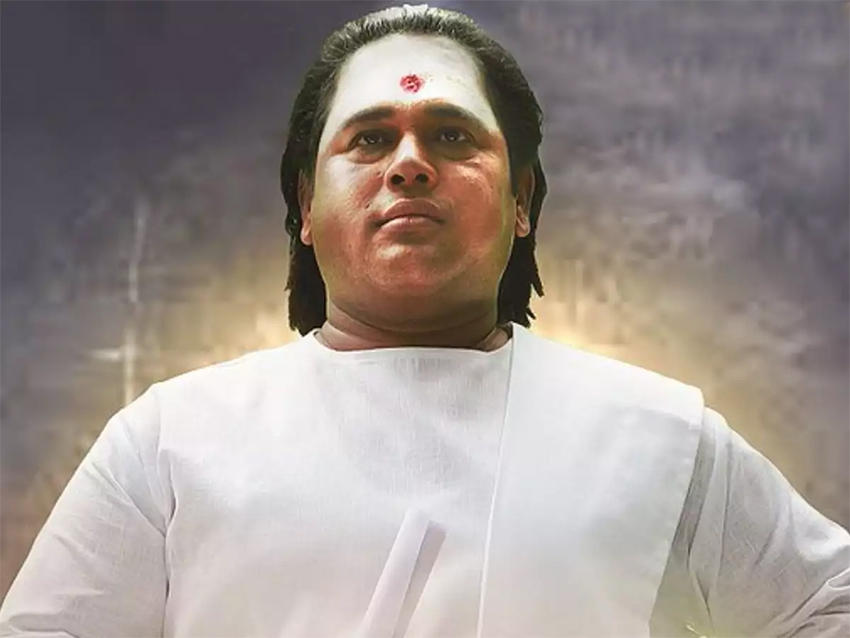
- He was a freedom-fighter-cum-spiritual leader. He is seen as a deity among the Mukulathor community, a cluster community comprising the Kallar, Maravar and Ahambadiar.
- People of the Mukulathor community still make offerings as is done for deities in temples to the statue on his Jeyanthi and Guru Pooja celebrations.
- He did not accept the traditional Hinduism because it supported ‘Varnashrama’. He always fought against the evils of Hindu religion.
- He openly condemned religious superstitions and narrow mindedness.
- He was a freedom-fighter-cum-spiritual leader. He is seen as a deity among the Mukulathor community, a cluster community comprising the Kallar, Maravar and Ahambadiar.
- Connection with Subhash Chandra Bose:
- Being a socialist and a colleague of Subhash Chandra Bose, he served as the national deputy chairman of All India Forward Bloc (AIFB) from 1952.
- He was elected three times to the national parliamentary constituency of AIFB.
- Being a socialist and a colleague of Subhash Chandra Bose, he served as the national deputy chairman of All India Forward Bloc (AIFB) from 1952.
- Temple Entry Movement:
- The Temple Entry Authorisation and Indemnity Act was passed by the government of C. Rajagopalachari in 1939.
- It removed restrictions prohibiting Dalits from entering Hindu temples.
- He supported this reform and in July 1939 he helped the activist A. Vaidyanatha Iyer taking Dalits to Meenakshi Temple in Madurai.
- The Temple Entry Authorisation and Indemnity Act was passed by the government of C. Rajagopalachari in 1939.
- Criminal Tribes Act:
- The Criminal Tribes Act (CTA), enacted by the British in 1920, against the Mukulathor community, against which Thevar protested by mobilising the people and launching protests that was a major milestone in his career.
- CTA criminalized entire communities by designating them as habitual criminals.
- He was instrumental in getting the act repealed after continuous efforts in 1946.
- The Criminal Tribes Act (CTA), enacted by the British in 1920, against the Mukulathor community, against which Thevar protested by mobilising the people and launching protests that was a major milestone in his career.
- Death:
- He died on 30th October in 1963 due to illness.
All India Forward Bloc
- It was formed in May 1939 by Subhash Chandra Bose. It was a left-wing nationalist political party in India which emerged as a faction within the India Congress in 1939.
- First All India Conference of Forward bloc was held in Nagpur in June 1940. And it passed a resolution titled 'All Power to the Indian People', urging militant action for struggle against British colonial rule.
- The prime objective of the Forward Bloc was to bring all radical elements of the Congress party together. So that it could spread the meaning of complete independence of India with adherence to the application of principles of equality and social justice.
- It was declared banned on 23 June 1942. Even when it was declared illegal, it played a revolutionary role to crown the struggle of the people with success and glory.
- The party re-established itself as an independent political party after the independence of India.
Important Facts For Prelims
Indian Navy Frigate Tushil: P1135.6 Class
Why in News
Recently, the 7th Indian Navy Frigate of P1135.6 class, named Tushil, was launched at Yantar Shipyard, Kaliningrad, Russia.
- The Indian and Russian governments had in October 2016 signed an agreement to construct four additional P1135.6 class ships -- two each in Russia and India.
Key Points
- Designed and built by Russia for the Indian Navy, the ship is formally named as ‘Tushil’.
- Tushil is a Sanskrit word meaning Protector Shield.
- Project 1135.6 is also known as Talwar Class — a class of guided-missile frigates.
- These are modified Krivak III-class frigates which are also the main basis of the Russian Admiral Grigorovich-class frigate.
- India has six Talwar class frigates in service.
- This ship is a potent combination of state-of-art Indian and Russian Weapons and Sensors equipped to operate in Littoral and Blue waters, both as a single unit and as consort in a naval task force.
- They feature “stealth technology” in terms of low radar and underwater noise signatures.
- Stealth technology is a low observable technology that makes aircraft, fighter jets, ships, submarines, satellites, missiles etc less visible to radar, infrared, sonar and other detection technologies.
- It highlights the long standing tradition of Military Technical Cooperation between India and Russia.
- They will add more power to the Indian Navy operating in the Indian Ocean Region (IOR).
Important Facts For Prelims
Ocean Research Vessel- Sagar Nidhi
Why in News
Recently, the Union Minister of Earth Sciences visited the Indian Subcontinent’s Pioneer Ocean Research Vessel (ORV) Ship SagarNidhi.
- Earlier, the Ministry of Earth Sciences (MoES) has launched India’s first manned ocean mission “Samudrayaan” in Chennai.
Key Points
- About:
- It was commissioned in 2008 for the country's marine research programme.
- It is the third research vessel after Sagar Purvi and SagarPaschimi.
- The vessel is capable of carrying out geo-scientific, meteorological and oceanographic research, and is designed with blue-water capability with ranges of up to 10,000 nautical miles (19,000 km) for voyages lasting up to 45 days.
- A blue-water capability refers to an oceangoing fleet able to operate on the high seas far from its nation's home ports.
- It is the first Indian flagged research ship that reached the 66°S latitude [Antarctic waters], facing 11 storms and 73 nm/hr wind speed, witnessing nature’s harshest conditions.
- MoES has, at present 6 ships, SagarNidhi, SagarManjusha, SagarKanya, SagarSampada, Sagar Tara & SagarAnveshika, which are used for many ocean studies and applications including ocean observations.
- It was commissioned in 2008 for the country's marine research programme.
- Significance:
- Research Vessels (Ships) are required for exploration and harnessing ocean resources for the Blue Economy and participation in search and rescue operations, more specifically for the implementation of the Deep Ocean Mission.
- It is used for launching tsunami monitoring systems and remotely operable vehicles, for identifying mines and gas hydrates
- It will also be used for conducting oceanic studies on the fuel of the future gas hydrates and search for scientific evidence about origin of life and cures for chronic diseases (Diseases that last one year or more).
Ministry of Earth Sciences (MoES)
- It has the mandate of providing weather, climate, Ocean and seismological services and to harness living and non-living resources.
- It is also involved in development of relevant Ocean Technology and Ocean Survey of the Exclusive Economic Zone (EEZ) and deep oceans for minerals and energy.
- National Institute of Technology (NIOT) Chennai has the mandate to develop technologies for the sustainable harvesting of living and non-living resources of the ocean.

